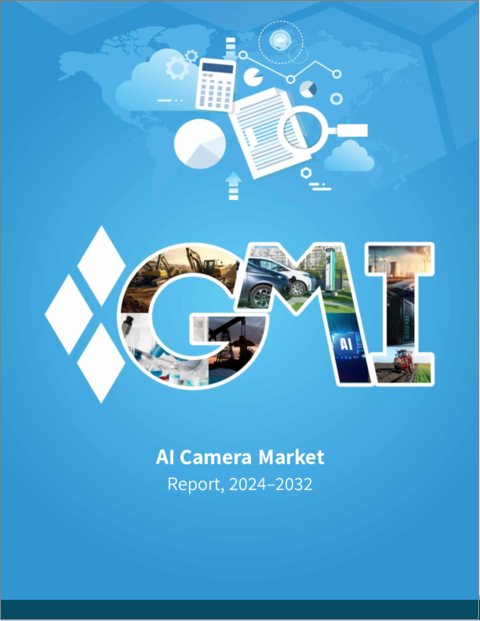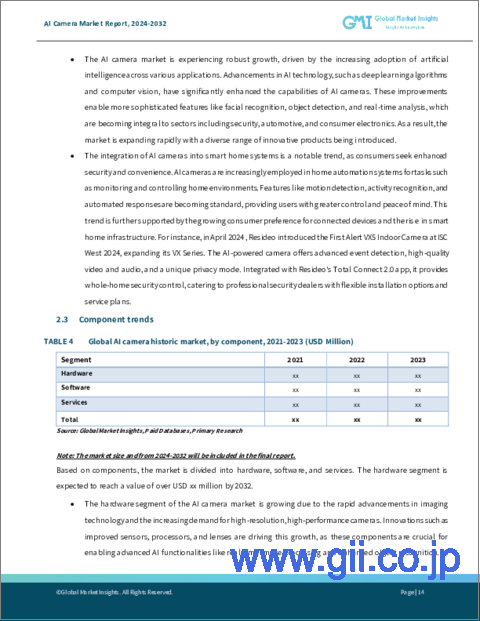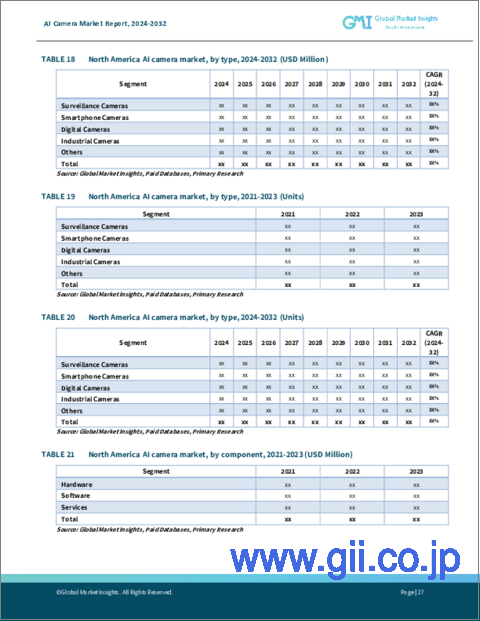|
|
市場調査レポート
商品コード
1615931
AIカメラ市場の機会、成長促進要因、産業動向分析、2024~2032年の予測AI Camera Market Opportunity, Growth Drivers, Industry Trend Analysis, and Forecast 2024 - 2032 |
||||||
カスタマイズ可能
|
|||||||
| AIカメラ市場の機会、成長促進要因、産業動向分析、2024~2032年の予測 |
|
出版日: 2024年09月04日
発行: Global Market Insights Inc.
ページ情報: 英文 186 Pages
納期: 2~3営業日
|
全表示
- 概要
- 目次
世界のAIカメラ市場は2023年に75億5,000万米ドルの評価額に達し、2024年から2032年にかけてCAGR18%で成長すると予測されています。
この急成長は、人工知能(AI)と機械学習の進歩により、AIカメラの機能が大幅に強化されたことによる。これらの高度なカメラは現在、物体検出、顔認識、行動分析などの複雑なタスクをより高い精度と効率で実行し、リアルタイムのデータ処理を可能にしています。この能力は、正確さと迅速な意思決定が求められる業界では特に価値が高いです。AIと機械学習技術が進化を続ける中、AIカメラは様々な分野で採用が拡大すると予想されます。
AIカメラの市場は、これらのカメラがサポートする多様な用途を反映して、タイプ、コンポーネント、技術、業界別、地域別に区分されています。コンポーネントセグメントは、ハードウェア、ソフトウェア、サービスに分けられます。ハードウェア・セグメントは、カメラ、センサー、プロセッサー、ストレージ・デバイスなどの要素を包含し、2032年までに145億米ドルを超えると見られています。センサーとプロセッサーの主要な技術進歩は、画質とAI能力を高めるため、このセグメントの成長にとって極めて重要です。AIプロセッサーを内蔵した高解像度カメラは、強力な視覚データの取り込みと処理機能を可能にし、このカテゴリーのトップドライバーの1つです。
業界別では、市場は家電、製造・小売、スポーツ、農業、ヘルスケア、自動車・輸送、政府・法執行などに区分されます。製造・小売分野は最も高い成長率が見込まれており、2024~2032年のCAGRは19.5%を超えると予測されています。民生用電子機器では、スマートフォン、セキュリティシステム、スマートホーム製品などの機器におけるハイテク機能の需要がAIカメラの成長を支えています。これらのデバイスは、顔認識、ジェスチャー制御、リアルタイムの物体検出など、強化されたAIカメラ機能の恩恵を受けています。地域別では、北米が2023年の世界のAIカメラ市場を独占し、市場シェア全体の38%以上を占めました。
| 市場範囲 | |
|---|---|
| 開始年 | 2023 |
| 予測年 | 2024-2032 |
| 開始金額 | 75億5,000万米ドル |
| 予想金額 | 340億米ドル |
| CAGR | 18% |
この地域の高度な技術インフラと急速なAIの導入がこのリーダー的地位を牽引しており、AIの研究開発への多額の投資と大手テクノロジー企業の存在により米国が主要企業となっています。AIカメラは北米の様々な用途で広く使用されており、この地域がセクターを問わず技術革新と自動化に取り組んでいることを裏付けています。
目次
第1章 調査手法と調査範囲
第2章 エグゼクティブサマリー
第3章 業界洞察
- エコシステム分析
- ベンダー・マトリックス
- 利益率分析
- テクノロジーとイノベーションの展望
- 特許分析
- 主要ニュースと取り組み
- 規制状況
- 影響要因
- 促進要因
- AIと機械学習アルゴリズムの進歩
- スマートな監視ソリューションに対する需要の高まり
- 家電製品へのaiカメラの統合
- 小売業やeコマースにおける採用の増加
- スマートシティに対する政府の取り組みと投資
- 業界の潜在的リスク&課題
- データプライバシーとセキュリティへの懸念
- 高い導入コストと技術的複雑性
- 促進要因
- 成長可能性分析
- ポーター分析
- PESTEL分析
第4章 競合情勢
- イントロダクション
- 企業シェア分析
- 競合のポジショニング・マトリックス
- 戦略展望マトリックス
第5章 市場推計・予測:タイプ別、2021年~2032年
- 主要動向
- 監視カメラ
- スマートフォンカメラ
- デジタルカメラ
- 産業用カメラ
- その他
第6章 市場推計・予測:コンポーネント別、2021年~2032年
- 主要動向
- ハードウェア
- ソフトウェア
- サービス
第7章 技術別市場推計・予測:技術別、2021年~2032年
- 主要動向
- 画像/顔認識
- 音声/音声認識
- コンピュータビジョン
- コンテキスト認識
- その他
第8章 市場推計・予測:業界別、2021年~2032年
- 主要動向
- 家電
- 製造・小売
- スポーツ
- 農業
- ヘルスケア
- 自動車・運輸
- 政府・法執行機関
- その他
第9章 市場推計・予測:地域別、2021年~2032年
- 主要動向
- 北米
- 米国
- カナダ
- 欧州
- 英国
- ドイツ
- フランス
- イタリア
- スペイン
- その他欧州
- アジア太平洋
- 中国
- インド
- 日本
- 韓国
- ニュージーランド
- その他アジア太平洋地域
- ラテンアメリカ
- ブラジル
- メキシコ
- その他ラテンアメリカ
- 中東・アフリカ
- UAE
- 南アフリカ
- サウジアラビア
- その他中東・アフリカ
第10章 企業プロファイル
- AV Costar
- Axis Communications AB
- Bosch Sicherheitssysteme GmbH
- Canon Inc.
- D-Link Corporation
- Fujitsu Ltd
- Hangzhou Hikvision Digital Technology Co., Ltd.
- Honeywell International Inc.
- Huawei Technologies Co., Ltd.
- Johnson Controls
- LG Electronics
- Nikon Corporation
- Panasonic Holdings Corporation
- Samsung Electronics Co., Ltd.
- Sony Corporation
- Swann
- Teledyne FLIR LLC
- VIVOTEK Inc
- Xiaomi Inc
- Zhejiang Dahua Technology Co. Ltd.
The Global AI Camera Market reached a valuation of USD 7.55 billion in 2023 and is forecasted to grow at a compound annual growth rate (CAGR) of 18% from 2024 to 2032. This rapid growth is driven by advancements in artificial intelligence (AI) and machine learning, which have significantly enhanced the functionality of AI cameras. These advanced cameras now perform complex tasks with higher accuracy and efficiency, including object detection, facial recognition, and behavior analysis, enabling real-time data processing. This capability is particularly valuable in industries that demand precision and fast decision-making. AI cameras are anticipated to see expanded adoption across various sectors as AI and machine learning technologies continue to evolve.
The market for AI cameras is segmented by type, component, technology, industry vertical, and region, reflecting the diverse range of applications these cameras support. The component segment is divided into hardware, software, and services. The hardware segment, encompassing elements such as cameras, sensors, processors, and storage devices, is set to surpass USD 14.5 billion by 2032. Key technological advances in sensors and processors are crucial to the segment's growth, as they enhance image quality and AI capabilities. High-resolution cameras with integrated AI processors are among the top drivers for this category, enabling powerful visual data capture and processing functions.
By industry vertical, the market is segmented into consumer electronics, manufacturing and retail, sports, agriculture, healthcare, automotive and transportation, government and law enforcement, among others. The manufacturing and retail segment is expected to experience the highest growth rate, with a projected CAGR exceeding 19.5% between 2024 and 2032. In consumer electronics, the demand for high-tech features in devices like smartphones, security systems, and smart home products supports the growth of AI cameras. These devices benefit from enhanced AI camera functionalities, such as facial recognition, gesture control, and real-time object detection. Regionally, North America dominated the global AI camera market in 2023, accounting for over 38% of the total market share.
| Market Scope | |
|---|---|
| Start Year | 2023 |
| Forecast Year | 2024-2032 |
| Start Value | $7.55 Billion |
| Forecast Value | $34 Billion |
| CAGR | 18% |
The region's advanced technological infrastructure and rapid AI adoption drive this leadership position, with the United States leading due to substantial investments in AI research and development and the presence of major technology companies. AI cameras are widely used across various applications in North America, underscoring the region's commitment to technological innovation and automation across sectors.
Table of Contents
Chapter 1 Methodology & Scope
- 1.1 Market scope & definition
- 1.2 Base estimates & calculations
- 1.3 Forecast calculation
- 1.4 Data sources
- 1.4.1 Primary
- 1.4.2 Secondary
- 1.4.2.1 Paid sources
- 1.4.2.2 Public sources
Chapter 2 Executive Summary
- 2.1 Industry 360° synopsis, 2021 - 2032
Chapter 3 Industry Insights
- 3.1 Industry ecosystem analysis
- 3.2 Vendor matrix
- 3.3 Profit margin analysis
- 3.4 Technology & innovation landscape
- 3.5 Patent analysis
- 3.6 Key news and initiatives
- 3.7 Regulatory landscape
- 3.8 Impact forces
- 3.8.1 Growth drivers
- 3.8.1.1 Advancements in AI and machine learning algorithms
- 3.8.1.2 Rising demand for smart surveillance solutions
- 3.8.1.3 Integration of ai cameras in consumer electronics
- 3.8.1.4 Increasing adoption in retail and e-commerce
- 3.8.1.5 Government initiatives and investments in smart cities
- 3.8.2 Industry pitfalls & challenges
- 3.8.2.1 Data privacy and security concerns
- 3.8.2.2 High implementation costs and technical complexity
- 3.8.1 Growth drivers
- 3.9 Growth potential analysis
- 3.10 Porter's analysis
- 3.10.1 Supplier power
- 3.10.2 Buyer power
- 3.10.3 Threat of new entrants
- 3.10.4 Threat of substitutes
- 3.10.5 Industry rivalry
- 3.11 PESTEL analysis
Chapter 4 Competitive Landscape, 2023
- 4.1 Introduction
- 4.2 Company market share analysis
- 4.3 Competitive positioning matrix
- 4.4 Strategic outlook matrix
Chapter 5 Market Estimates & Forecast, By Type, 2021 - 2032 (USD million & Units)
- 5.1 Key trends
- 5.2 Surveillance cameras
- 5.3 Smartphone cameras
- 5.4 Digital cameras
- 5.5 Industrial cameras
- 5.6 Others
Chapter 6 Market Estimates & Forecast, By Component, 2021 - 2032 (USD million & Units)
- 6.1 Key trends
- 6.2 Hardware
- 6.3 Software
- 6.4 Services
Chapter 7 Market Estimates & Forecast, By Technology, 2021 - 2032 (USD million & Units)
- 7.1 Key trends
- 7.2 Image/face recognition
- 7.3 Voice/speech recognition
- 7.4 Computer vision
- 7.5 Context awareness
- 7.6 Others
Chapter 8 Market Estimates & Forecast, By Industry Vertical, 2021 - 2032 (USD million & Units)
- 8.1 Key trends
- 8.2 Consumer electronics
- 8.3 Manufacturing & retail
- 8.4 Sports
- 8.5 Agriculture
- 8.6 Healthcare
- 8.7 Automotive & transportation
- 8.8 Government & law enforcement
- 8.9 Others
Chapter 9 Market Estimates & Forecast, By Region, 2021 - 2032 (USD million & Units)
- 9.1 Key trends
- 9.2 North America
- 9.2.1 U.S.
- 9.2.2 Canada
- 9.3 Europe
- 9.3.1 UK
- 9.3.2 Germany
- 9.3.3 France
- 9.3.4 Italy
- 9.3.5 Spain
- 9.3.6 Rest of Europe
- 9.4 Asia Pacific
- 9.4.1 China
- 9.4.2 India
- 9.4.3 Japan
- 9.4.4 South Korea
- 9.4.5 ANZ
- 9.4.6 Rest of Asia Pacific
- 9.5 Latin America
- 9.5.1 Brazil
- 9.5.2 Mexico
- 9.5.3 Rest of Latin America
- 9.6 MEA
- 9.6.1 UAE
- 9.6.2 South Africa
- 9.6.3 Saudi Arabia
- 9.6.4 Rest of MEA
Chapter 10 Company Profiles
- 10.1 AV Costar
- 10.2 Axis Communications AB
- 10.3 Bosch Sicherheitssysteme GmbH
- 10.4 Canon Inc.
- 10.5 D-Link Corporation
- 10.6 Fujitsu Ltd
- 10.7 Hangzhou Hikvision Digital Technology Co., Ltd.
- 10.8 Honeywell International Inc.
- 10.9 Huawei Technologies Co., Ltd.
- 10.10 Johnson Controls
- 10.11 LG Electronics
- 10.12 Nikon Corporation
- 10.13 Panasonic Holdings Corporation
- 10.14 Samsung Electronics Co., Ltd.
- 10.15 Sony Corporation
- 10.16 Swann
- 10.17 Teledyne FLIR LLC
- 10.18 VIVOTEK Inc
- 10.19 Xiaomi Inc
- 10.20 Zhejiang Dahua Technology Co. Ltd.





